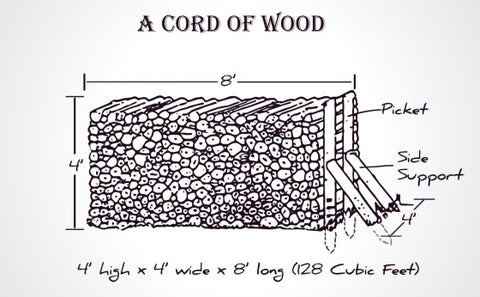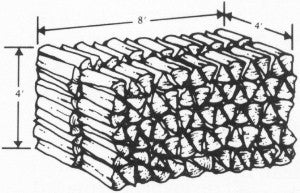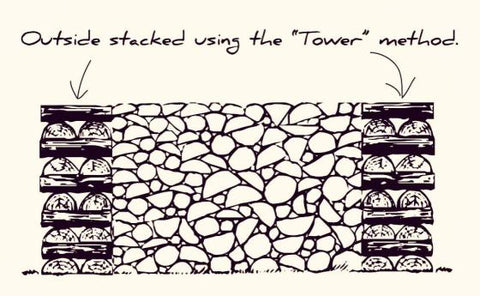Firewood Fundamentals
Oct 15, 2014
“A house is not a home unless it contains food and fire for the mind as well as the body.” – Benjamin Franklin, Founding Father
The beginning of fall is the perfect time of year to begin planning for firewood. The weather is starting to cool, inviting men to hunt, to hike, and to simply be outside and enjoy the season. Whether it’s for an outdoor fire pit (my favorite) or heating inside the home, you’ll need a good stack, or several, of firewood. The terms and techniques surrounding firewood are beginning to fade from the common knowledge of modern man. Hopefully this article will inspire a few of us to rekindle our passion for wood burning.
Cording Your Wood
When discussing firewood people typically talk in terms of cords, ricks, or face cords. If you are buying firewood it is really important to know how much wood you should be getting. Don’t settle for a “load” of wood in the back of a truck when paying for a “cord” of wood.
A Cord of Wood

A Cord of Wood is 4′ high x 4′ wide x 8′ long
When laying out a place for your wood stack, you should make it at least 4′ wide by 8′ long or break it up in some way that you still have 128 cubic feet. Typicall the firewood will be precut to 16″ pieces — the typical size for stove wood — or 24″ pieces (2 feet) — for an outdoor or larger fireplace — so you will have either three or two stacks of wood all bundled together totaling 128 cubic feet. See the illustration below for an idea of a cord of wood where the pieces are cut to 24″ lengths.

A cord of wood with pieces cut at 24″.
When stacking your wood, make sure it is “racked and ranked” meaning very little spaces between the wood to ensure you have a full cord. There are different methods for stacking your wood which will allow for better airflow and thus drying (seasoning), but when determining the total volume of wood, having it split and traditionally stacked is the best method. Also, if ordering the wood, it should be pre-seasoned so airflow doesn’t matter.
A Face Cord of Wood
A Face Cord is simply one stack of a cord of wood with pieces cut at 24″. In other words, one row of 8′ long x 2′ wide x 4′ high rather than two.
A Rick Cord of Wood
A Rick Cord is similar to a Face Cord but they are not the same. While a Face Cord is 2′ wide, a Rick Cord can be any width. For example, stove wood is usually cut to 16″, so a Rick would be one row of 8′ long x 16″ wide x 4′ high rather than three rows for a full Cord.
How Many Cords do I need?
The number of Cords of wood you need is based on several factors including the type of wood you will burn, the length of the cold months, how large of a space you will heat, and any other uses you may have for firewood such as cooking or heating water. For the man who just wants a little firewood for an outdoor fire pit, one face cord a year will suffice. For the person who is heating a small ranch home through the winter months in my neck of the woods (North Carolina\Tennessee) 4 cords will likely be needed. Those further up north will need somewhere between 6 and 10 cords of wood. In most cases, people try to get way ahead of themselves when they seriously rely on wood for heat. If a quick and intense winter comes along you might not be able to get out and harvest as much wood as you hoped.
Woods to Burn
Beechwood fires are bright and clear
If the logs are kept a year.
Chestnut only good, they say,
If for long ’tis laid away.
But Ash new or Ash old
Is fit for Queen with crown of old.Blaze up bright and do not last.
It is by the Irish said
Hawthorn bakes the sweetest bread.
Elm wood burns like churchyard mold
E’en the very flames are cold.
But Ash green or ash brown
Is fit for queen with golden crown.Poplar gives a bitter smoke,
Fills your eyes and makes you choke.
Apple wood will scent your room
With an insence like perfume.
Oaken logs,if dry and old,
keep away the winter’s cold.
But ash wet or ash dry
a King shall warm his slippers by.– Anonymous English Poet
Splitting, stacking, and hauling firewood to its destination is a pretty big chore so you will want to be particular about the types of woods you use to make sure you get the most burn for your buck (or your back). As noted in the old English poem above, Ash and Oak are considered premium fire woods while Hickory is also an excellent choice but likely was not available in the poets area. Hardwoods have a slower growth rate, growing more densely than the softwoods so they burn longer. Evergreens, such as Pine, should be avoided as firewood inside the home. This isn’t because they are toxic, they are just fine for burning, but because they have a high sap ratio and when the sap burns it creates a “damp fire” which leaves a residue on the inside of the chimney called creosote. Creosote is flammable and can lead to chimney fires. A little pine for starting a fire, kindling, is probably alright, but if you have a lot of pine, save it for the outdoor fire pit or bonfire.
Seasoning Wood
Before any wood can be used to create a great fire, it has to be seasoned, which is just a way of saying “dried out”. This isn’t the same thing as aging wood, which leads to a break-down of the cells and rot and does not burn very well. Seasoned wood will still be heavy and dense. Here are a few rules to follow when setting up your firewood to season.
Cut down trees in the late fall or winter months – After the trees have lost their leaves they also release sap back into their roots. Otherwise, they may explode in a severe freeze. This means the wood will dry much more quickly than a tree harvested in the Summer or Spring.
Split the wood while it’s green – Split wood will dry fast and be easier to split when it is still green. Hardwoods such as oak and hickory only become more dense when the moisture has evaporated and harder to split.
Season your wood in a warm dry area – If possible, place your cords of wood in direct sunlight. If building a woodshed, built it in direct sunlight and make sure there are wide gaps in the side boards to allow air flow.
Keep the wood covered – Cover your woodpile with a tarp, just on the top of the wood, not the whole stack. Airflow is key to drying out wood but so is keeping the rain off.
Wait a minimum of six months before using the wood – In most cases, the wood gathered this winter will be ready next winter.
Stacking Firewood
There are many ways to stack firewood but the most common is to use the “tower” method on the outside of the stack and traditionally stack the wood on the inside. See the illustration below for an example.
On key thing to remember, a little lean in a stack will be come a big lean as the year goes by and it is nearly impossible to correct a leaning stack of wood without restacking. Fix any leans early in the process or else you’ll spend your time fixing a larger mess later.

Use the “tower” method as the end caps and fill the rest with evenly sized pieces.
Final Thoughts
As a kid I used to spend hours splitting and stacking firewood. It sounds like a grueling chore but it is actually one of my fondest memories. The rest of the winter, as the wood would be brought in to burn, I would have a sense of pride knowing I contributed to the family in a very real and tangible way. Even if you don’t intend to warm your home using wood, you’ll be surprised how quickly a stack will go to use even in suburbia using fire pits and small bonfires.


 “A house is not a home unless it contains food and fire for the mind as well as the body.” – Benjamin Franklin, Founding Father
“A house is not a home unless it contains food and fire for the mind as well as the body.” – Benjamin Franklin, Founding Father
